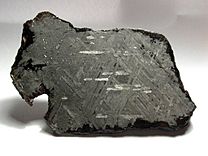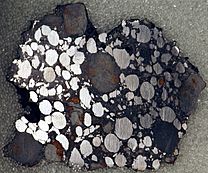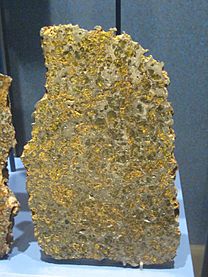M-type asteroid facts for kids

M-type asteroids are a special kind of asteroid. Scientists think these space rocks have a lot of metal inside them, like iron and nickel. Many believe that M-type asteroids are the source of iron meteorites found on Earth.
Contents
What are M-type Asteroids?
Scientists sort asteroids into different groups based on how they reflect light. This is called their "spectral type." M-type asteroids have a unique way of reflecting light, which looks mostly flat or slightly reddish. They also have a medium brightness, which scientists call "optical albedo."
M-type asteroids are part of a bigger family called X-type asteroids. This group also includes E-type and P-type asteroids. The main way to tell these three types apart is by how bright they are:
| P-type | Very dim (albedo less than 0.1) |
| M-type | Medium bright (albedo between 0.1 and 0.3) |
| E-type | Very bright (albedo more than 0.3) |
What are M-type Asteroids Made Of?
Composition
Even though we call them "M-type" (for metal), we don't directly see the metal. Instead, the evidence that they are rich in metal is indirect. For example, the light they reflect is similar to that of iron meteorites. Also, special radar observations show that M-type asteroids reflect radar signals very strongly. This is what you would expect from objects with lots of dense materials like iron and nickel.
Most M-type asteroids reflect radar signals at least twice as strongly as common S-type or C-type asteroids. About one-third of them reflect radar signals three times as strongly!
However, some studies show that M-type asteroids also have other materials. They sometimes show signs of silicates (rocky minerals). Some even have "hydrated silicates," which means they contain water locked inside their minerals. Finding silicates, especially hydrated ones, is a bit surprising if these asteroids were just pure metal cores.
Density and Porosity
The "bulk density" of an asteroid tells us how much stuff is packed into its space. It helps scientists guess what the asteroid is made of. For M-type asteroids, the materials they might be made of (like meteorites) have densities from about 3 grams per cubic centimeter (for some rocky meteorites) to nearly 8 grams per cubic centimeter (for pure iron-nickel).
Knowing an asteroid's density also helps us figure out its "porosity." Porosity tells us how much empty space (like tiny holes) is inside the asteroid. This helps us understand if an asteroid is a solid rock or a "rubble pile" (a collection of loosely held pieces).
Measuring an asteroid's mass and volume is tricky because they are small.
- To find an asteroid's mass, scientists watch how its gravity affects other objects. This could be other asteroids or spacecraft flying nearby. If an asteroid has one or more moons, scientists can use the moons' orbits to figure out the asteroid's mass.
- To find an asteroid's volume, scientists need to know its size. They often guess the size from how bright it is (its albedo) or by watching it pass in front of a star (an "occultation"). Sometimes, they use heat signals from the asteroid. For a few asteroids, like 16 Psyche or 216 Kleopatra, astronomers have even made 3D models of their shapes!
Here are some M-type asteroids and their estimated densities:
| Asteroid | Density (g/cm³) | Radar Albedo | How it was measured |
|---|---|---|---|
| 16 Psyche | 3.8 ± 0.3 | 0.34 ± 0.08 | Gravity effects, shape model |
| 21 Lutetia | 3.4 ± 0.3 | 0.24 ± 0.07 | Rosetta spacecraft flyby, direct pictures |
| 22 Kalliope | 4.1 ± 0.5 | 0.15 ± 0.05 | Orbit of its moon Linus, shape model |
| 69 Hesperia | 4.4 ± 1.0 | 0.45 ± 0.12 | Gravity effects, heat/radar size |
| 92 Undina | 4.4 ± 0.4 | 0.38 ± 0.09 | Gravity effects, heat/radar size |
| 129 Antigone | 3.0 ± 1.0 | 0.36 ± 0.09 | Gravity effects, heat/radar size |
| 216 Kleopatra | 3.4 ± 0.5 | 0.43 ± 0.10 | Orbits of its two moons, shape model |
The most reliable ways to measure an asteroid's mass are by spacecraft flying by or by observing its moons. The most reliable ways to measure its size are from direct spacecraft images or detailed shape models.
None of the M-type asteroids seem to be made of pure iron-nickel. This means they likely contain other materials, like silicates. Many scientists now think that most large M-type asteroids are made of a mix of materials, similar to certain types of meteorites like enstatite chondrites or metal-rich carbonaceous chondrites. Some might even be rubble piles.
How M-type Asteroids Formed
Scientists have different ideas about how M-type asteroids came to be.
- One early idea was that M-type asteroids were the leftover cores of early protoplanets. These protoplanets were like baby planets that formed long ago. The idea was that huge crashes in the early solar system stripped away the outer layers of these protoplanets, leaving behind only their metal cores. Some smaller M-type asteroids (less than 100 km wide) might have formed this way.
- However, this idea was challenged for 16 Psyche, the biggest M-type asteroid. It's unlikely that Psyche, which started as a large protoplanet, would have been completely stripped while other similar-sized objects like Vesta remained mostly whole. Also, scientists haven't found a "family" of smaller asteroids that would have been created from such a huge crash. Instead, some scientists suggest that Psyche was a protoplanet that broke apart and then slowly came back together due to gravity. This new object would be a mix of iron and rocky materials.
- Another idea is that the largest M-type asteroids, including 16 Psyche, might have formed closer to the Sun. They could have lost their outer layers while they were still hot and partly melted. Later, they moved to their current location in the asteroid belt.
- A third idea is that the largest M-types, like 16 Psyche, might have been "differentiated bodies." This means they separated into layers, like Earth has a core, mantle, and crust. With the right mix of iron and other elements, these asteroids might have had a type of "iron volcanism" (called ferrovolcanism) as they cooled down.
Famous M-type Asteroids
Out of nearly 1,000 asteroids classified by the Tholen system, only about 38 are M-type. Another 10 were first called X-type but are now considered M-type because of their brightness. Overall, M-type asteroids make up about 5% of all classified asteroids.
(16) Psyche
16 Psyche is the largest M-type asteroid. It is about 222 km (138 miles) wide. Its surface reflects radar signals very strongly, suggesting it has a lot of metal in its top layers. The Psyche spacecraft is planned to visit 16 Psyche in 2029 to learn more about it.
(21) Lutetia
21 Lutetia is about 100 km (62 miles) wide. It was the first M-type asteroid ever seen up close by a spacecraft! The Rosetta space probe flew past it on July 10, 2010. Lutetia's surface also reflects radar signals strongly, suggesting it has more metal than other asteroids. Data from Rosetta showed that Lutetia's surface materials are similar to certain types of rocky meteorites that contain iron.
(22) Kalliope
22 Kalliope is the second largest M-type asteroid, about 150 km (93 miles) wide. It has a small moon named Linus, which was found in 2001. Linus's orbit helps scientists figure out Kalliope's exact mass. Unlike most M-types, Kalliope's radar reflection is not super strong, meaning its surface might not be as metal-rich. However, it has a high density, suggesting it's quite solid.
(216) Kleopatra
216 Kleopatra is the third largest M-type asteroid, about 122 km (76 miles) wide. It has a very unusual shape, like a "dog-bone" or "dumbbell." This shape suggests it might be two asteroids that gently touched and stuck together. Radar observations show that Kleopatra's southern part reflects radar signals very strongly, which points to a metal-rich makeup. Kleopatra also has two small moons, named Alexhelios and Cleoselena. Their orbits helped scientists accurately calculate Kleopatra's mass and density.
See also
 In Spanish: Asteroide de tipo M para niños
In Spanish: Asteroide de tipo M para niños






